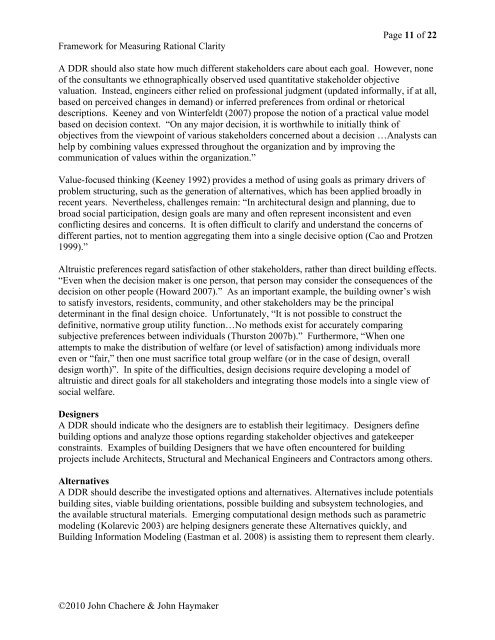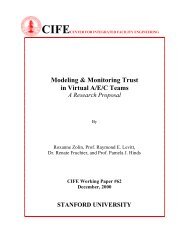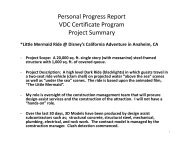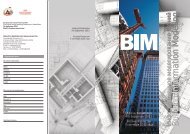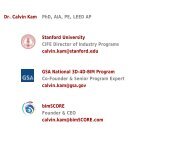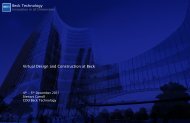Framework for Measuring Rationale Clarity of AEC Design Decisions
Framework for Measuring Rationale Clarity of AEC Design Decisions
Framework for Measuring Rationale Clarity of AEC Design Decisions
Create successful ePaper yourself
Turn your PDF publications into a flip-book with our unique Google optimized e-Paper software.
<strong>Framework</strong> <strong>for</strong> <strong>Measuring</strong> Rational <strong>Clarity</strong><br />
Page 11 <strong>of</strong> 22<br />
A DDR should also state how much different stakeholders care about each goal. However, none<br />
<strong>of</strong> the consultants we ethnographically observed used quantitative stakeholder objective<br />
valuation. Instead, engineers either relied on pr<strong>of</strong>essional judgment (updated in<strong>for</strong>mally, if at all,<br />
based on perceived changes in demand) or inferred preferences from ordinal or rhetorical<br />
descriptions. Keeney and von Winterfeldt (2007) propose the notion <strong>of</strong> a practical value model<br />
based on decision context. “On any major decision, it is worthwhile to initially think <strong>of</strong><br />
objectives from the viewpoint <strong>of</strong> various stakeholders concerned about a decision …Analysts can<br />
help by combining values expressed throughout the organization and by improving the<br />
communication <strong>of</strong> values within the organization.”<br />
Value-focused thinking (Keeney 1992) provides a method <strong>of</strong> using goals as primary drivers <strong>of</strong><br />
problem structuring, such as the generation <strong>of</strong> alternatives, which has been applied broadly in<br />
recent years. Nevertheless, challenges remain: “In architectural design and planning, due to<br />
broad social participation, design goals are many and <strong>of</strong>ten represent inconsistent and even<br />
conflicting desires and concerns. It is <strong>of</strong>ten difficult to clarify and understand the concerns <strong>of</strong><br />
different parties, not to mention aggregating them into a single decisive option (Cao and Protzen<br />
1999).”<br />
Altruistic preferences regard satisfaction <strong>of</strong> other stakeholders, rather than direct building effects.<br />
“Even when the decision maker is one person, that person may consider the consequences <strong>of</strong> the<br />
decision on other people (Howard 2007).” As an important example, the building owner’s wish<br />
to satisfy investors, residents, community, and other stakeholders may be the principal<br />
determinant in the final design choice. Un<strong>for</strong>tunately, “It is not possible to construct the<br />
definitive, normative group utility function…No methods exist <strong>for</strong> accurately comparing<br />
subjective preferences between individuals (Thurston 2007b).” Furthermore, “When one<br />
attempts to make the distribution <strong>of</strong> welfare (or level <strong>of</strong> satisfaction) among individuals more<br />
even or “fair,” then one must sacrifice total group welfare (or in the case <strong>of</strong> design, overall<br />
design worth)”. In spite <strong>of</strong> the difficulties, design decisions require developing a model <strong>of</strong><br />
altruistic and direct goals <strong>for</strong> all stakeholders and integrating those models into a single view <strong>of</strong><br />
social welfare.<br />
<strong>Design</strong>ers<br />
A DDR should indicate who the designers are to establish their legitimacy. <strong>Design</strong>ers define<br />
building options and analyze those options regarding stakeholder objectives and gatekeeper<br />
constraints. Examples <strong>of</strong> building <strong>Design</strong>ers that we have <strong>of</strong>ten encountered <strong>for</strong> building<br />
projects include Architects, Structural and Mechanical Engineers and Contractors among others.<br />
Alternatives<br />
A DDR should describe the investigated options and alternatives. Alternatives include potentials<br />
building sites, viable building orientations, possible building and subsystem technologies, and<br />
the available structural materials. Emerging computational design methods such as parametric<br />
modeling (Kolarevic 2003) are helping designers generate these Alternatives quickly, and<br />
Building In<strong>for</strong>mation Modeling (Eastman et al. 2008) is assisting them to represent them clearly.<br />
©2010 John Chachere & John Haymaker


